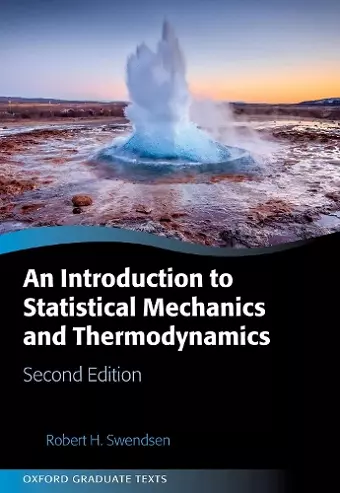An Introduction to Statistical Mechanics and Thermodynamics
Format:Hardback
Publisher:Oxford University Press
Published:10th Dec '19
Should be back in stock very soon
This hardback is available in another edition too:
- Paperback£39.99(9780198907787)

An Introduction to Statistical Mechanics and Thermodynamics returns with a second edition which includes new chapters, further explorations, and updated information into the study of statistical mechanics and thermal dynamics. The first part of the book derives the entropy of the classical ideal gas, using only classical statistical mechanics and an analysis of multiple systems first suggested by Boltzmann. The properties of the entropy are then expressed as "postulates" of thermodynamics in the second part of the book. From these postulates, the formal structure of thermodynamics is developed. The third part of the book introduces the canonical and grand canonical ensembles, which are shown to facilitate calculations for many model systems. An explanation of irreversible phenomena that is consistent with time-reversal invariance in a closed system is presented. The fourth part of the book is devoted to quantum statistical mechanics, including black-body radiation, the harmonic solid, Bose-Einstein and Fermi-Dirac statistics, and an introduction to band theory, including metals, insulators, and semiconductors. The final chapter gives a brief introduction to the theory of phase transitions. Throughout the book, there is a strong emphasis on computational methods to make abstract concepts more concrete.
Review from previous edition In his innovative new text, Carnegie Mellon University physics professor Robert Swendsen presents the foundations of statistical mechanics with, as he puts it, a detour through thermodynamics. That's a desirable strategy because the statistical approach is more fundamental than the classical thermodynamics approach and has many applications to current research problems. [] The mathematical notation is carefully introduced and useful; the selected mathematical techniques are clearly explained in a conversational style that both graduate and advanced undergraduate students will find easy to follow. The author's subject organization and conceptual viewpoint address some of the shortcomings of conventional developments of thermal physics and will be helpful to students and researchers seeking a deep appreciation of statistical physics. * Physics Today, August 2013 *
Bob Swendsen's book is very well thought out, educationally sound, and more original than other texts. * Jan Tobochnik, Kalamazoo College, USA *
Robert Swendsen is a well-respected researcher who has developed many novel algorithms that illustrate his deep understanding of statistical mechanics. His textbook reflects his deep understanding and will likely have a major impact on the way statistical mechanics and thermodynamics is taught. Particularly noteworthy is Swendsen's treatment of entropy, following Boltzmann's original definition in terms of probability, and his comprehensive discussion of the fundamental principles and applications of statistical mechanics and thermodynamics. Students and instructors will enjoy reading the book as much as Swendsen obviously enjoyed writing it. * Harvey Gould, Clark University, USA *
In this reader-friendly, excellent text, the author provides a unique combination of the best of two worlds: traditional thermodynamics (following Callen's footsteps) and modern statistical mechanics (including VPython codes for simulations). * Royce Zia, Virginia Polytechnic Institute and State University, USA *
Swendsen is famous for developing Monte Carlo algorithms which dramatically speed up the simulation of many systems near a phase transition. The ideas for those algorithms required deep understanding of statistical mechanics, an understanding which is now fully applied to this excellent textbook. * Peter Young, University of California, USA *
ISBN: 9780198853237
Dimensions: 252mm x 175mm x 29mm
Weight: 1104g
496 pages
2nd Revised edition